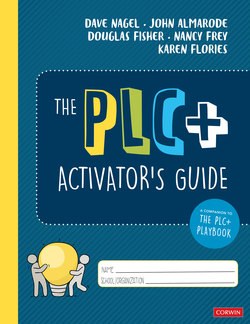Читать книгу The PLC+ Activator’s Guide - Douglas Fisher - Страница 14
На сайте Литреса книга снята с продажи.
Ensuring Fidelity to PLC+ Without Rigidity
ОглавлениеA critical task activators must do is to ensure that their PLC+ is a PLC+. PLCs are not static; they grow and develop over time as a reflection of the answers to each of the five guiding questions, as well as according to the evolution of the crosscutting values. Increased efficacy, the assurance of equity, and the professional growth of colleagues into activators sets up our schools and classrooms to be dynamic, innovative, and progressive learning spaces. As activators, we must help the PLC+ develop a structure that is malleable, adjusting for the many nuances and natural interwoven elements a group of diverse educators brings to the table. Successful implementation of any professional learning in a school requires adaptation. Penuel, Phillips, and Harris (2014) examined educational research related to the implementation of programs in schools to help determine which stages of implementation could inform development and improve practice. One of their core findings was the need for adaptations at what they called the “local contexts” (p. 752). In an earlier paper, Penuel, Frank, Fishman, Sabelli, and Cheng (2009) cite McDonald (2009), who noted that if programs could not adapt to a range of contexts and be usable in those contexts, implementation of those programs might falter and negatively impact outcomes. In this case, the program is similar to the work of the PLC+. Activators make sure that the structure they provide their PLC+ team is like the structure provided in a classroom in which they teach, a structure with clearly defined cognitive, social, and emotional learning outcomes but with multiple pathways toward those outcomes. To take this a step further, activators recognize when adaptive approaches are needed to carry out the work of the PLC+.
Penuel and his colleagues (2009) also cited evidence that teachers’ adaptations of any program are congruent with designers’ intentions, seeking to distinguish “creative transformations” from “lethal mutations” in teachers’ enactments (A.L. Brown & Campione, 1996; M.W. Brown & Edelson, 2001). They went on to say that poor implementation can diminish the potential impact and strength of any program, making it less likely to point to how the program led to positive impacts on student learning (Cordray & Pion, 2006).
As activators, we must ensure that the focus of the team’s efforts and actions stays within the confines of a true PLC+. There is intentionality in how the PLC+ framework was developed. Skipping questions or cherry-picking values would, for example, not be true to the model and could lead to outcomes that were never intended during this work. As a specific example, working through the guiding question “Where are we now?” before working through the guiding question “Where are we going?” will lead to low expectations. If we first focus on where are learners are now, we are likely to then set expectations that are biased toward that starting point. Phrases such as “Well, that is about as much as they can handle” or “They can’t do that” permeate the conversation space. These low expectations tip the equity scale out of balance, lowering the efficacy of the individual teachers and thus the collective efficacy of the PLC+ team. Again, there is intentionality in how the PLC+ framework was developed.
A “lethal adaptation” cannot happen if the team understands clearly and uses all of the guiding questions and crosscutting values. As activator, you ensure the model in its entirety is used as intended; you use this structure to shape and form the dialogue, discussions, and decisions the team generates collectively. Activators make sure the sidelines and boundaries for the team are clear.
Be the Catalyst: Using your response to the above reflection on teacher credibility, list the adaptations you believe are necessary for your local context. Then, outline the steps you will take as the activator to make those adaptions. Keep in mind that these adaptions may be opportunities to provide time for other members to be responsible for making the meeting a success (see on page 18 of this guide the fourth item in the list of the ways to build collaborative maturity).
______________________________________________________________________________________
______________________________________________________________________________________
______________________________________________________________________________________
______________________________________________________________________________________
______________________________________________________________________________________
______________________________________________________________________________________
______________________________________________________________________________________
______________________________________________________________________________________
______________________________________________________________________________________
______________________________________________________________________________________
______________________________________________________________________________________
______________________________________________________________________________________
______________________________________________________________________________________
______________________________________________________________________________________
______________________________________________________________________________________
______________________________________________________________________________________
______________________________________________________________________________________
______________________________________________________________________________________
______________________________________________________________________________________
______________________________________________________________________________________
______________________________________________________________________________________
______________________________________________________________________________________
